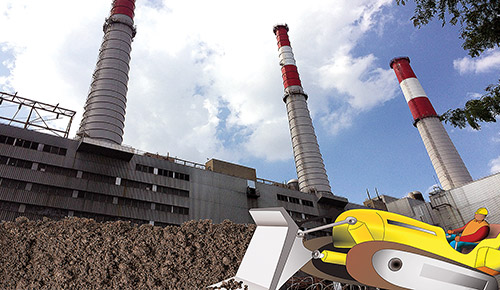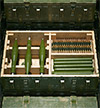Cultivate a Second Life for Decommissioned Power Plants
As the need for industrial development grows and requirements for coal-fired decommissioning increase, land repositioning can offer a mutually beneficial solution.
Q1 2021

Decommissioned power plant sites offer industrial developers a great deal of opportunity — specifically, decades of well-maintained assets. The majority of these facilities were built more than 50 years ago with access to everything they needed to operate — connections that would require extensive time and capital investments to put in place today. Rather than seeking greenfield locations, industrial developers should take a closer look at repositioning these sites.
Revealing Exceptional Value
Coal-fired power plants are sprawling sites, teeming with invaluable assets. To establish a buffer between facilities and the communities served, these plants were often placed on hundreds of acres with distribution lines and substations installed to transmit the power generated. Infrastructure to accommodate water and wastewater needs was constructed, and multimodal transportation connections were established to bring materials in and out of the plant.
Coal-fired power plants are sprawling sites, teeming with invaluable assets. Industrial developers can take advantage of these well-maintained, high-value assets and breathe new life into their purpose. For example, distribution lines that sent power out can be reversed to bring power into a new industrial facility, and a rail or barge connection that brought coal to the plant can be used to take products and materials in or out of a facility. Developers can take advantage of the permitting and regulatory hurdles that had been overcome by the utilities in years past, generating a potential savings today in both time and money.
Repositioning of expansive decommissioned sites also offers multiuse possibilities. Most industrial facilities don’t require the hundreds of acres that former power plant sites offer. Therefore, a campus arrangement could position several viable solutions within one site, such as a solar field for the utility or developer as well as multiple locations for different facilities — offering load gains for the utility and a cost-effective green approach for industrial developers.
Mapping Out the Possibilities
To optimize a property and its correlating repositioning benefits, a utility should develop a master plan for a future industrial campus on its site before any decommissioning begins. This approach would commence with an assessment of the site to determine what should remain after decommissioning, and what may be lacking when complete. It is then advised to undergo a thorough analysis of both natural and built-environment attributes to achieve a vision of property diligence and any potential impediments to development.
Once existing conditions are understood, a general regional market review can determine local- and state-level tax advantages, industrial cluster presence, and any high-level property assets that might align within specific markets. From there, the property can be decommissioned to meet the design requirements through development of a master plan to directly position it to specific industrial audiences.
Repositioning of expansive decommissioned sites also offers multiuse possibilities. This robust review and flexible development plan is thorough and granular in its details, which is essential. After all, not every asset will appeal to every industry, and not every industry that needs a certain asset exists in a region. For example, grain unloading in agricultural areas would use the site differently, and require different assets, than a sand and gravel mining area. Therefore, a thoughtful master plan can cast the widest net based on the site location, assets, and market.
Including the master planning upfront in the decommissioning process can also help pinpoint potential challenges and adjust the design or business case accordingly. For instance, aging plant facilities might require asbestos or subsurface remediation or be located on protected wetlands — situations that could increase liabilities and costs that could exceed the value of the property. Or an existing rail connection might be viewed as an asset but is so outdated that the rail line no longer serves the area. By identifying these possible limitations early in the process, a utility can have confidence in the direction of its approach, making decommissioning more cost-effective and focused on its end goal.
Due to the broad potential markets and industries for repositioning, a utility should involve its economic development staff — either internally or from the local and/or regional level — to discuss the goals and targets for the site. It wouldn’t be surprising for the site development to include a marriage of public and private investments; thus, economic development insight is vital. The utility should also consider partnering with a full-service firm to provide preferably both the decommissioning and master-planning services. If a firm can offer guidance and continuity from site and facility assessments, environmental remediation, design, construction, and more, the utility will be able to secure the optimal solution.
Including the master planning upfront in the decommissioning process can help pinpoint potential challenges and adjust the design or business case accordingly. Establishing Benefits for Everyone
Repositioning of decommissioned power plant sites is a win-win for utilities and industrial developers. Utilities can convert unused sites, with their potential safety and environmental hazards, into increased load capacity and a boon for their local communities. Doors closing on coal-fired power plants are eliminating jobs nationwide. By bringing established assets like these sites to market, utilities can be part of generating industrial growth in their regions and reinvigorating their communities’ labor opportunities.
At the same time, industrial developers can streamline cost-effective site development by utilizing existing sites that boast valuable assets. Already ideally positioned efficiently for operations, decommissioned power plant sites allow industries to start fresh — but with the most essential connections already in place from the start. Repositioning offers a unique, mutually beneficial opportunity for utilities, developers, and communities alike. Rather than removing everything during decommissioning, take the time to understand the value of existing assets and put them back to work.
Project Announcements
First Solar Plans Gaffney, South Carolina, Operations
11/15/2025
Norway-Based Vianode Plans St. Thomas, Ontario, Canada, Operations
11/14/2025
Ireland-Based CEL Critical Power Plans James City County, Virginia, Manufacturing Operations
11/13/2025
Aclara Resources Plans Calcasieu Parish, Louisiana, Heavy Rare Earth Separation Operations
11/04/2025
Eos Energy Enterprises Expands Allegheny County, Pennsylvania, Operations
11/01/2025
Germany-Based Becker Mining Systems Plans Mount Vernon, Ohio, Manufacturing Operations
10/18/2025
Most Read
-
The Workforce Bottleneck in America’s Manufacturing Revival
Q4 2025
-
Rethinking Local Governments Through Consolidation and Choice
Q3 2025
-
First Person: Filter King’s Expansion Playbook
Q3 2025
-
Lead with Facts, Land the Deal
Q3 2025
-
How Canada Stays Competitive
Q3 2025
-
Investors Seek Shelter in Food-Focused Real Estate
Q3 2025
-
America’s Aerospace Reboot
Q3 2025



